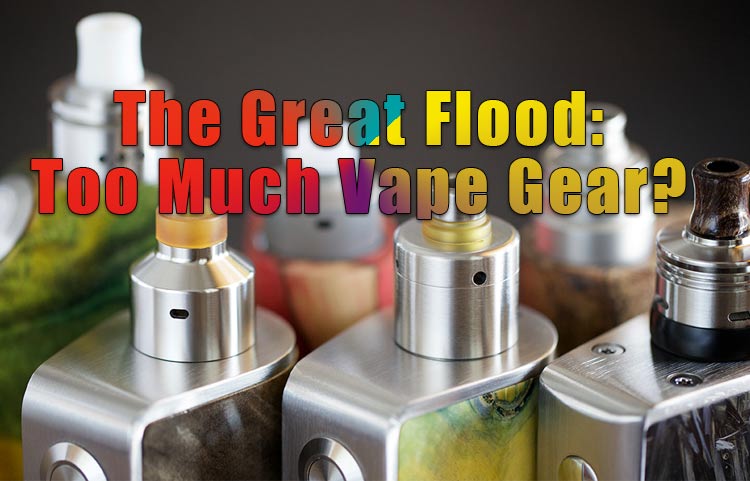Last Updated on October 6, 2018 by Team Spinfuel
Is today’s vape industry packed, crowded, and flooded with vaporizers and vape tanks? Are hundreds of choices of vape gear, especially vaporizers, something we really need? Or are they just the same devices wearing different brandings? Join us as we take a look at the current state and condition of today’s vape industry and whether or not the proliferation of vape products is good for both businesses and consumers.
Vaporizers have taken a great leap in the past decade. It was first introduced into the European market in 2006 and in the United States the year after. It was something nobody has heard of but became a mainstream means of consuming materials for recreational and medical purposes.
Vaporizers have had a long history, that of which can be traced back to ancient times where early civilizations heated herbs and oils on hot stones. Modern vaping history suggests that the idea of electronic powered vaping devices began around the early 1920s. An invention for a “smokeless non-tobacco cigarette” was patented in 1965 although the idea of commercializing the said apparatus did not happen until the late 80s. Those who believed and supported the noble cause of vaporizers and their smokeless benefits encountered a fork in the road when the American FDA did not allow electronic cigarettes to enter the market during the 90s.
The idea of vaping versus smoking spread ever since and became popular in European countries. It was a hit and became one of the most recommended means of herb consumption in the said region, especially where ingestion of medical and casual cannabis is considered legal. In the year 2000, a Chinese pharmacist made the first modern e-cigarette – the likes of what we see today. Since then, the vaporizer trade has skyrocketed and led to what now is a million-dollar industry where almost every able businessman wants to get their share on this ever-growing racket. The FDA has raised its embargo on vaporizers and many have followed suit seeing the benefits of vaping over conventional smoking.

Vaporizers, The New Goldmine
The term “goldmine” usually refers to a rich source, either of money or anything one desires. The vaporizer industry has seen substantial and significant growth in such a small amount of time, it’s a promising area of investment that can spell the difference between fad and fortune. It’s a goldmine for people who see new technologies as an opportunity to cash in and ride the hype train to financial boom.
The vaporizer industry is said to have had worldwide sales of $7 billion in 2014 based on a report by famed online business and financial press platform, the Wall Street Journal. Similarly, European financial analysts predict that the UK sales of £1 billion on vaporizers are expected to hit twice its current value, an all-time high, in the year 2020.
You can’t blame businesses both big and small to look this way given all the approving analysis and the positive probes on the vaporizer industry. Startups begin by purchasing generic vaporizers from manufacturers in the birthplace of the modern portable electronic cigarette and slap their branding to make it their own. Those who bought rights on developing the product start their own research to advance and expand their horizon. This gave way to better and more sophisticated vaping technology which can most of the time be seen as a step ahead of the average vaporizer. The likes of which include magnetic connections, adjustable airflow and so on. The number of players who want to delve in this ever-growing industry provides vaping a rich ecosystem of brands, vaporizers, vape gears, and accessories. A study was conducted in 2014 and have reported over 460 vape brands around the world. The report also noted that there were 7,700 vape flavors of relatively similar e-liquids around the globe. It’s been four years and the number of local and global vape manufacturers and re-sellers continue to multiply. We see a surge of vaporizers and almost something new can be found in every vape shop both virtual and physical almost on a weekly basis.
The Great Vape Race
Because the market is littered with vaporizers and products that provide basically the same benefit, every brand aims to separate themselves from the competition either by revolutionizing its product’s base form or by innovating the model altogether. That’s why we see vaporizers come out almost every week where it comes to the point that it can be overwhelming to the novice and the inexperienced. It gives us a plethora of products that more or less offer the same set of features although they are marketed to be something different. In a business where competition is tough, companies learned to harness the power of typecasting.
Different brands sell their items as lifestyle merchandise, some even go as far as branding themselves as that of professional and medical-grade products that claim to exceed the quality of the average vaporizer. Some use the power of advertising and collaborate with famous artists in almost every industry related to vaping and produce spinoffs of literally one single commodity.
All these factors give vaping a whole new spectrum of ideology and turned a hobby into a lifestyle, and ultimately into a culture.
Yay or Nay?
The growth and development of the vaporizer industry is the perfect example of what the law of supply and demand is.
The more the variety of products are made available, the less the value of the product is perceived to be. The price of a vaporizer then is significantly higher than what it would cost you to start vaping now. The Business Insider South Africa reported that vaporizers “became 4% cheaper over the past 2 years in South Africa.” In the United States, prices have considerably dropped from 2012 to 2016. However, these price drops proved to be beneficial to vape manufacturers and resellers as well. The price drop in 2012 to 2016 brought about a 132% increase in vaporizer sales and the 12% markdown on electronic cigarettes as reported by CDC spelled an increase in sales on vape products in general.
This only concludes that the growth of the vape industry is both favorable to consumers and manufacturers and almost anyone else in between – from resellers to middlemen.
Final Thoughts
The choices that we have in vaporizers in general and the increased competition in vape manufacturers and vape businesses is a good indication that the industry is stabilizing. Because of the growth of the vaping industry, what was once an unregulated form or medication and recreation is now being scrutinized by governments of their respective regions where vaping has become popular. It’s no longer considered an insignificant trend but is now seen as a legitimate replacement for traditional cigarette smoking and that it poses a great threat to the tobacco industry. We now see laws that are specifically structured to govern vaping which only means that it’s now accepted as a social norm and the old stigma on vaporizers have been replaced with a positive perspective.
Vape brands like Dr. Dabber have been at the forefront of innovation and gave the vaping community more than just simple and rudimentary versions of vaporizers and vape gears. These companies make the industry in general flourish with options that elevate one’s vaping experience and prove that there’s no such thing as having too many vaporizers or vape gears. They say that a rolling stone gathers no moss, an old proverb that fits and perfectly describes the current status of today’s vaping industry. It’ll only continue to rise and the choices the current industry offers – whether we need them or not – will only prove to be a contributing factor to the inevitable expansion of the vaping industry.








